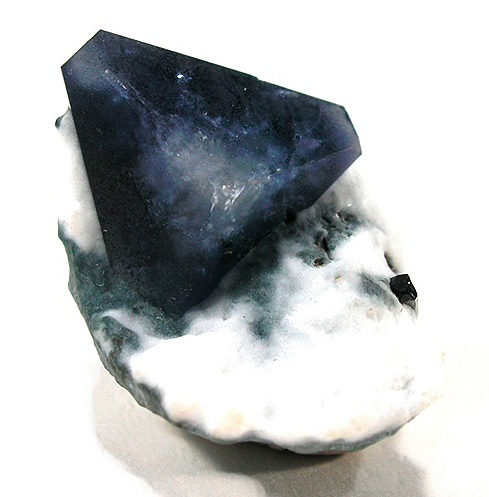The Mineral benitoite

Benitoite was first discovered in 1907, and upon its initial discovery was thought to be Sapphire. The crystal structure of Benitoite is unique, and is the only significant mineral in its crystal class. It crystallizes in a rare hexagonal sub-class called ditrigonal-dipyramidal.
Most Benitoite crystals were originally deeply embedded in thick Natrolite; specimens are prepared for
collectors by dissolving the surrounding Natrolite in acid to expose
the Benitoite crystals. The blue Benitoite on a white Natrolite matrix and usual association with black Neptunite makes a very aesthetic mineral
specimen.
Benitoite is named after its locality in San Benito Co. in California, where this mineral was first found in a remote area far from civilization. This region is the only source of Benitoite, aside from some very sporadic and extremely limited occurrences worldwide.
For additional information, see the gemstone section on Benitoite.
Chemical Formula
BaTiSi3O9
Color
Light blue to deep indigo blue. Also bluish-gray and purplish-blue. May be zoned with lighter and darker color regions and white zones.
Crystal Habits
In well-formed, tabular crystals that are triangular in shape, often with slightly flattened points or sub-triangular points. Crystals may be in isolated crystals or interconnected. Twinning as stubby hexagonal prisms are also known, and a rare oddity is a perfectly aligned penetration twin shaped as a star of David.
Uses
Benitoite is cherished by collectors as a rare and valuable mineral. It is also cut as as an exquisite rare gemstone.
Noteworthy Localities
The only significant locality for Benitoite is the Diablo
Range, near the headwaters of the San Benito River, in the Southern tip of San Benito Co.,
California. Virtually all collectors specimens for this mineral are from
this area. The now-closed Dallas Gem Mine in the Diablo Range has been the source of most of the available material and the largest crystals. Other localities in the area include the Santa Rita Peak, the Victor Claim, the Number One Mine, and the Junnila Mine. In Japan, a very limited occurrence of small gemmy Benitoite is Hashidate, Itoigawa, Niigata Prefecture, Japan.
Common Mineral Associations
Natrolite, Neptunite, Serpentine, Albite, Glaucophane, Joaquinite, Crossite
Distingushing Similar Minerals
The crystal habits, color, and locality are able to distinguish Benitoite from all other minerals.